The following brief examples show the kinds of improvements that can be achieved with equine podiatry. If you want to see what barefoot horses are capable of, the EPA web site has a photo gallery here.
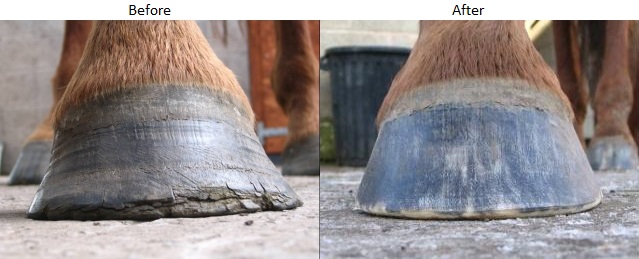
This thoroughbred was flat footed and had a strong tendency to flaring in the hooves. After 6 months, the hooves improved well and gained a good degree of concavity. The horse was then able to cope with reasonable amounts of road work without shoes.
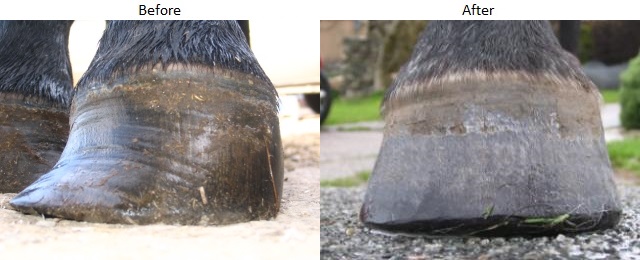
This youngster’s feet had been neglected and a serious imbalance had gone uncorrected. 12 months later, the foot is now straight. These photos nicely show that hoof shape is determined by environment far more than by conformation and can be improved.
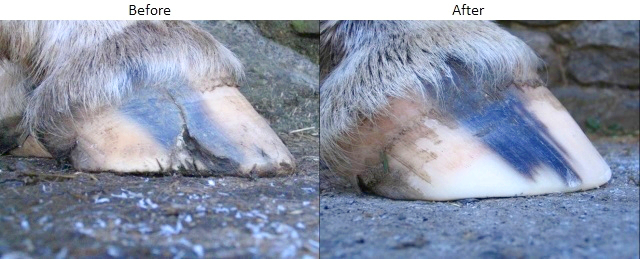
This foot had a tiny bit of damage to the coronary band which resulted in a weakness in the hoof. A combination of poor trimming and rampant infections had resulted in a crack so deep the two sides moved independently of each other. After 6 months and lots of disinfectant, the crack has healed nicely. This horse now happily gallops along stony tracks without shoes or boots.
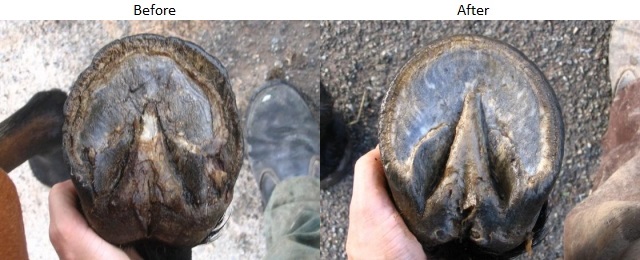
This horse developed a serious infection of the white line which had eaten away the much of the heels and done quite a bit of damage to the wall as well. A combination of careful trimming and the consistent use of disinfectants resulted in all the damage growing out in just 4 months. Some subtle changes in diet are ensuring that the problem does not recur.
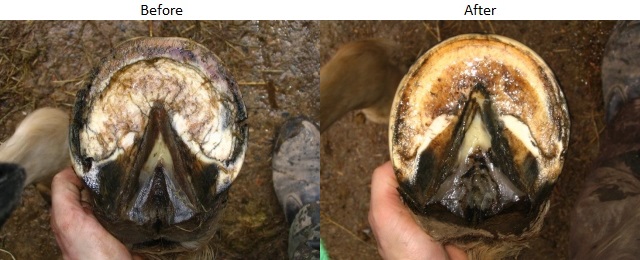
This young mare had only been shod for a year. She has naturally good feet and was sound from the moment the shoes were pulled. The main thing the feet needed was conditioning – getting them used to being used on hard surfaces. She was ridden on roads from day one with the amount of hard ground work and the severity of the surfaces gradually increased over a period of a few weeks. After four months, she was up to pretty much anything her owner could throw at her. A year later, her feet are amongst the best I work with (the foot shown above scores 7.4 out of 10… which is a pretty good score in the UK). She routinely copes with lots of road work, riding at speed on stony mountain tracks, jumping and hunting.
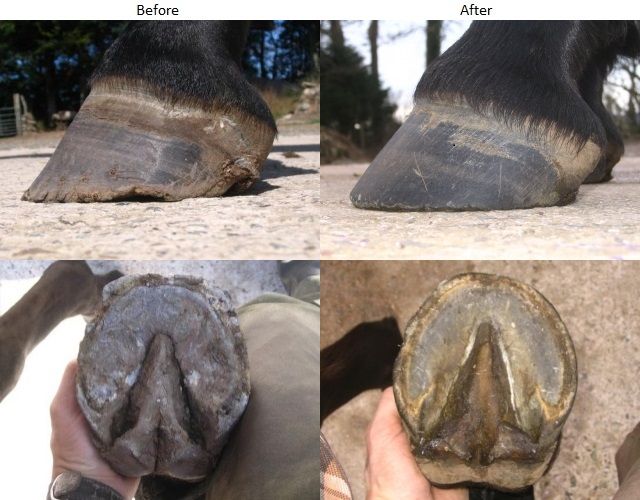
This young hannovarian gelding had been shod for around a year but the owner was concerned that the feet were losing quality and wanted to try a barefoot approach. The horse was constantly pulling off the front shoes suggesting that the walls weren’t holding nails well and the horse may have been uncomfortable. The feet were essentially in moderately good shape apart from superficial distortions and low level wall infections. He was rideable on soft ground straight after removal of shoes and was rideable for short distances (a few miles per week) on smooth tarmac/concrete within 6-8 weeks. Within 3 months he was sound on all surfaces. After 7 months (as per the photos here) his feet are now in very good shape and he is working well on all surfaces including a significant amount of road work.
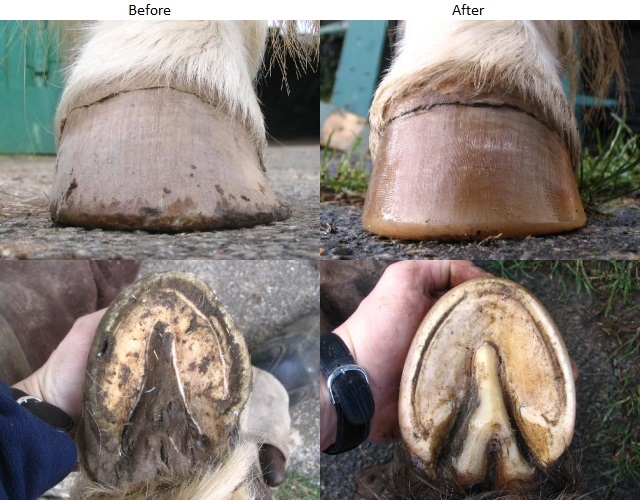
This Welsh Section B pony was already ‘sound’ but plaited on the fronts and hinds. He showed some signs of dietary problems – in particular a degree of flaring that was not explained by his conformation. His initial score was 4.8 out of 10. Ten months later, he now has extremely good feet and scores 6.9 overall. As can be seen from the photos above of the right hind, the imbalances in the feet have fully corrected and he now has a straight action both in front and behind. The excessive flaring has totally disappeared and his hoof walls are straight from the coronary band to the ground. His owner had always worried about the lack of straightness in his action but is now thrilled with the way he moves.
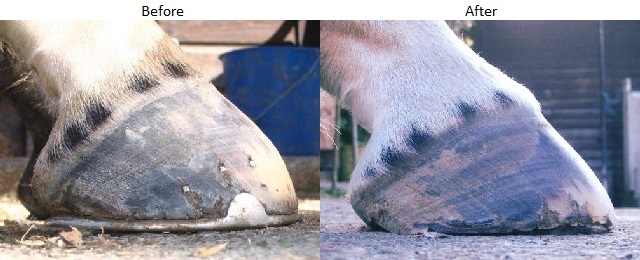
Usually it takes months to get improvements in feet, but sometimes I get really quick wins. This 9 year old hannovarian had a history of back pain and tendon problems in the hind legs. Her owner felt that she did not move well in the school. The hind feet were a pretty bad shape as you can from the photo of the right hind above. The heels were collapsed and under-run (look at the angle of the wall tubules at the heel) and the toe was badly bull-nosed (curved backwards). Removing the shoes and trimming a better balance on the feet gave an almost immediate improvement. The second photograph was taken just 4 weeks later. Already you can see that there is more heel height and that the heel tubules have become more upright. In that time, the horse’s gait has improved dramatically and the owner feels that there has been a massive improvement in the way she works. This horse is a complex case and this represents only the start of the process. A lot more work is needed over the coming months to get the feet in really good shape – much of which will depend on getting her diet right – but the improvement in the first 4 weeks is very promising.
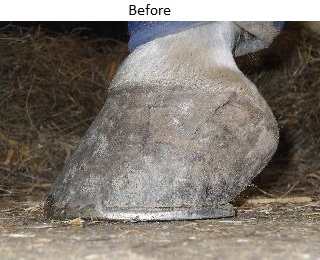
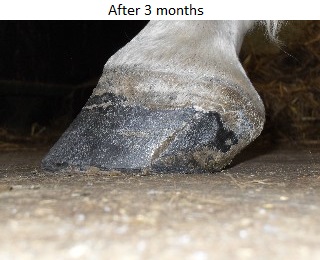
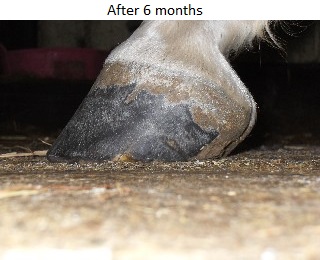
This horse had a history of his right fore being very slightly more toe in than his left fore – probably the result of an injury very early in life. Despite this, he performs well at the highest levels in dressage. He’d had generally good feet but had been sent abroad for a couple of years for training. While away he developed a very subtle lameness on the right fore (which only showed in advance work). The vet and farrier came up with a shoeing approach which they claimed kept him sound (including a pad under the shoe). When he came back to the UK he was still borderline lame on the right fore. The local farrier removed the pad but otherwise kept the shoeing approach. After some months he went suddenly more lame on the right fore and I was asked to look at him. The right fore was slightly out of balance side-to-side… the shoeing approach had included trying to ‘correct’ the toe-in on the right fore. The heels were also massively high on that foot (they were fairly high on the other front) resulting in the pedal bone being tipped forward by about 10 degrees more than it should have been. The biggest issue though was a severe crack on the inside quarter which went into the coronary band and showed evidence of recent bleeding. The lateral cartilage on that side of the foot was shunted downwards and forwards in such a way as to create a significant change of angle in the hairline right where the crack originated. Effectively, the shoeing approach was crushing the heel forward, creating a sharp kink in the coronary band and the crack was the result. I removed the shoes and rebalanced the feet (allowing the right fore to return to its original slight toe in conformation). Within a few days he achieved full soundness, even in advanced work. He’s not had a lame day since. The crack grew out over a six month period and the lateral cartilage on that side gradually relaxed into a more normal position without the kink in the coronary band. The gradual straightening of the hairline can be clearly seen in the photos.
An Example of a Good Foot
People keep asking me what a good foot should look like. The answer is that it depends on things like the breed and what kind of work the horse is doing (e.g. work on soft ground, work on hard ground, etc.). However, this foot should give you an idea of what you’re aiming for:
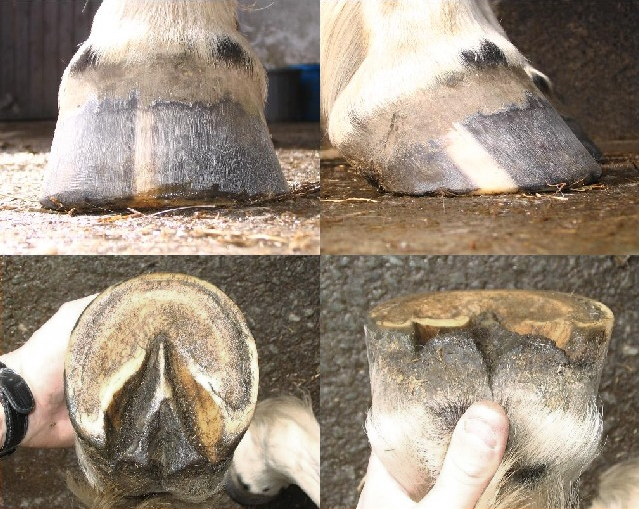
This is from a 15hh2 Irish Sports Horse aged 8 that does quite a bit of hacking (including lots of mountain tracks and roads), hunting, show jumping, cross country and some dressage. The horse only ever had shoes on for about a year and has now been barefoot for around 2 years. The foot shown (a front foot) scores 8.6 out of 10 (a very high score for the UK). This horse is capable of doing long distance rides on stony tracks (e.g. 60 miles on the Mary Townely Loop in Lancashire) without boots.
This foot is quite upright and has very little flaring. Although these photos are post-trim, the trim was pretty much cosmetic – just removing minor chips and rounding sharp edges. The foot has a strong frog, strong heels and bars and a full digital cushion. You can see that although this foot is nicely concave for a front foot (hind feet should be a little more concave still), there is a broad flat rim of sole that is on the ground. In horses that work a lot on hard ground, you get a rim of sole that is weight bearing in addition to the wall. On this horse, there’s a good area of wall on the ground, but the sole rim contributes more weight bearing area than the wall does. A horse working more on soft ground would tend to have a slightly deeper concavity and less sole on the ground.